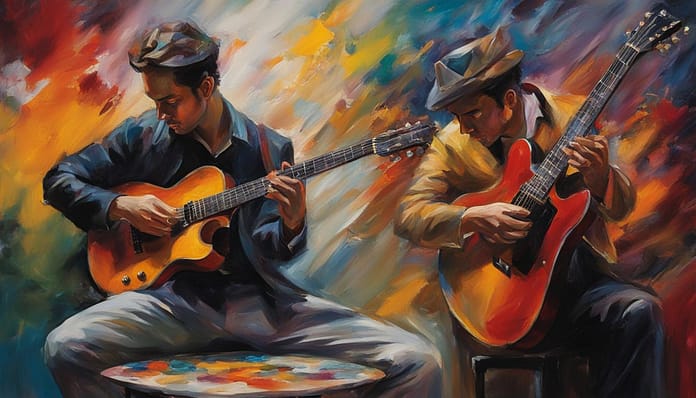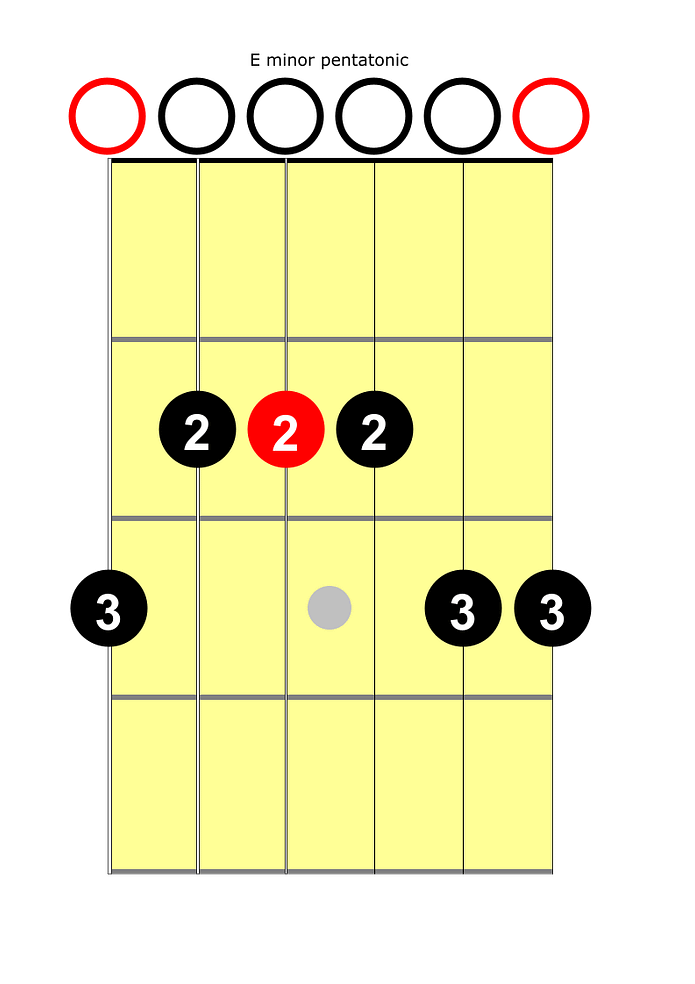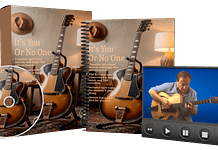This post may contain affiliate links. As an Amazon associate, Google associate as well as associate for other programs, Guitar & Music Institute may earn commissions from qualifying purchases.

Improvisation is an essential skill in guitar playing, allowing you to express your creativity on the fretboard. It involves making up music on the spot, without pre-planning or following a set structure. Famous guitarists like Eric Clapton, Jimi Hendrix, and John Mayer have all showcased their improvisation skills. There are step-by-step methods and exercises you can follow to learn and improve your guitar improvisation skills.
At GMI Guitar Shop, we offer a wide range of free and paid guitar books and downloads that can help you further develop your guitar improvisation techniques, exercises, and tips.
Key Takeaways:
- Improvisation is a valuable skill for guitarists to express their creativity.
- Famous guitarists like Eric Clapton, Jimi Hendrix, and John Mayer are known for their improvisation skills.
- There are step-by-step methods and exercises available to improve your guitar improvisation.
- Visit our website for a wide range of free and paid guitar books and downloads to enhance your improvisation skills.
- Developing your ear and listening to music in various genres will aid in improving your improvisation abilities.
The Basics of Guitar Improvisation
Improvisation on the guitar doesn’t require any magical talent, but rather a step-by-step approach. It’s important to start by developing your ear, which involves listening and understanding the musical context. You can begin by learning a scale shape, such as the 7-note major scale, which serves as the foundation for improvisation.
There are various techniques and exercises you can practice to start improvising guitar solos:
- Playing along to backing tracks
- Using root notes and random notes from a scale
- Experimenting with different notes and rhythms
As you progress, you can explore different genres like jazz, blues, and rock to further enhance your improvisation skills. Whether you’re a beginner or more advanced, the key is to keep practicing and experimenting with new ideas.
Check out our latest free and paid guitar books and downloads at https://gmiguitarshop.com/.
Beginner Guitar Improvisation Techniques
To get started with guitar improvisation, here are some beginner techniques you can try:
- Playing simple melodies using the major scale
- Adding slides and bends to create expression
- Experimenting with different rhythm patterns
These techniques will help you develop your improvisation skills and build confidence on the guitar.
Jazz Guitar Improvisation
Jazz guitar improvisation requires a solid understanding of music theory and chord progressions. Some techniques to explore in jazz improvisation include:
- Using arpeggios to outline chord changes
- Incorporating chromatic notes for added tension and color
- Experimenting with different scales and modes
By studying and analyzing the improvisations of jazz guitarists like Charlie Parker and Wes Montgomery, you can begin to develop your own unique jazz style.
Blues Guitar Improvisation
Blues guitar improvisation is rooted in the pentatonic scale and emphasizes expressive techniques like bending and vibrato. Here are some tips for blues guitar improvisation:
- Start with the minor pentatonic scale
- Add in the blues scale for added bluesy flavor
- Experiment with call and response phrases
Listening to blues legends like B.B. King and Stevie Ray Vaughan can provide inspiration and help you develop your blues guitar improvisation skills.
Rock Guitar Improvisation
Rock guitar improvisation is all about energy and attitude. Some techniques to incorporate into your rock improvisation include:
- Utilizing power chords and palm muting for a heavier sound
- Adding in legato techniques like hammer-ons and pull-offs
- Experimenting with different effects like distortion and delay
Listening to rock guitarists like Jimmy Page and Eddie Van Halen can give you ideas and inspiration for your own rock guitar improvisations.
| Genre | Techniques |
|---|---|
| Jazz | Arpeggios, chromatic notes, different scales and modes |
| Blues | Minor pentatonic and blues scales, bending, vibrato, call and response phrases |
| Rock | Power chords, palm muting, legato techniques, effects |
Beginner Improvisation Guitar Lesson
If you’re a beginner looking to develop your guitar improvisation skills, Andrew Clarke’s beginner improvisation guitar lesson offers a unique and effective approach. This lesson takes a departure from the traditional focus on blues and instead centers around contemporary pop and rock chord progressions. By learning in this way, you’ll be able to apply the skills you acquire to any genre of music.
The lesson begins by introducing a simple 7-note major scale shape, serving as the foundation for improvising guitar solos. This scale shape is easy to learn and provides a solid starting point for beginners. Alongside the practical exercises, the lesson also emphasizes the importance of playing along to relevant music.
To make the exercises more enjoyable and memorable, it’s recommended to play along to songs with similar chord progressions. For example, practicing improvisation while playing along to John Mayer’s “Slow Dancing In A Burning Room” can add an element of fun and inspiration to your learning journey.
Throughout the lesson, you’ll gradually progress from playing the scale shape to incorporating root notes, experimenting with playing random notes, and eventually reaching the point of improvising freely. This step-by-step approach ensures that you build a solid foundation in guitar improvisation while honing your creative skills.
Beginner Guitar Solo Techniques
If you’re new to guitar improvisation, Darrell Braun’s lead guitar lesson offers valuable insights into beginner solo techniques, specifically in the blues genre. By incorporating these techniques into your playing, you can spice up your improvisation and take your solos to the next level.
Darrell demonstrates a range of techniques that add texture and expression to your solos:
- Repeating notes: By repeating certain notes or phrases, you can create memorable and catchy melodies.
- Varying the tempo: Playing with the tempo can add dynamics and create tension in your solos.
- Changing directions: Switching between upward and downward movements on the fretboard adds interest and fluidity to your playing.
- Skipping strings: Incorporating string skips adds a unique and unconventional sound to your solos.
- Articulation techniques: Sliding, bending, double-stops, and vibrato are all techniques that add expression and emotion to your playing.
It’s important to note that these techniques require some dexterity and control, so it’s essential to master the basics of scales and positioning before diving into them.
Remember, practice is key to developing your own unique style in guitar improvisation. By gradually incorporating these techniques into your playing, you’ll enhance your improvisation skills and create captivating solos that leave a lasting impression.

Recommended Blues Guitar Solos:
| Song | Artist | Genre |
|---|---|---|
| Statesboro Blues | The Allman Brothers Band | Blues Rock |
| Pride and Joy | Stevie Ray Vaughan | Blues |
| The Thrill Is Gone | B.B. King | Blues |
| Red House | The Jimi Hendrix Experience | Blues Rock |
Pentatonic Scales and Blues Scale
When it comes to guitar improvisation, pentatonic scales are a go-to choice for many musicians. These scales are incredibly versatile and can be applied to various musical styles, including blues and rock. They provide a solid foundation for creating melodic phrases and ideas in improvisation.
Let’s start with the E minor pentatonic scale, which is one of the most commonly used pentatonic scales. Here’s a diagram and finger positions to help you visualize:


By mastering the E minor pentatonic scale, you can easily transpose it to other keys, allowing you to explore different tonalities and create unique guitar solos.
Now, let’s dive into the blues scale, which is derived from the pentatonic scale. The blues scale adds “blue” or “flattened” notes, giving it a distinct and bluesy sound. It opens up even more possibilities for improvisation, especially in genres like jazz, reggae, and blues.
As you become more comfortable with the pentatonic and blues scales, don’t hesitate to experiment with other jazz scales like Mixolydian, Lydian, and Dorian. These scales can add complexity and depth to your improvisation, taking your guitar solos to the next level.
Remember, practice is key when it comes to guitar improvisation. Spend time exploring different scales, playing along to backing tracks, and experimenting with melodic ideas. With dedication and perseverance, you’ll develop your own unique style and become a confident improviser on the guitar.
Check out our latest free and paid guitar books and downloads at https://gmiguitarshop.com/.
Note Ornamentation and Melodic Techniques
Note ornamentation is a vital component of advanced guitar improvisation. It involves utilizing techniques such as string bends, vibrato, legato, and slides to manipulate the pitch, duration, and articulation of the notes. These embellishments add depth, expression, and character to your solos, allowing you to convey your musical ideas with precision and emotion.
In order to master note ornamentation, it is essential to practice each technique individually and then gradually incorporate them into your playing. By overusing specific techniques during practice, you will become more comfortable with them and naturally integrate them into your solos. Aim to strike a balance between utilizing ornamentation techniques effectively and preserving the melodic flow of your improvisation.
Additionally, melodic techniques play a crucial role in advanced guitar improvisation. These techniques involve adding chord tones, altering rhythms, and utilizing embellishments such as suspensions, anticipations, and appoggiaturas. By incorporating these melodic variations into your improvisation, you can create intricate and captivating solos that engage the listener and bring a unique flavor to your playing.
To further enhance your understanding of note ornamentation and melodic techniques, consider experimenting with different genres and styles of music. By exploring various musical contexts, you can expand your repertoire of improvisational tools and develop a versatile and well-rounded playing style.
Ornamentation and Melodic Techniques
| Technique | Description |
|---|---|
| String Bends | Bending a string to raise the pitch of a note |
| Vibrato | Rapidly fluctuating the pitch of a note for added expression |
| Legato | Articulating notes smoothly and connecting them without pauses |
| Slides | Moving from one note to another by sliding along the fretboard |
| Chord Tones | Incorporating notes from the underlying chords to create harmonic interest |
| Changing Rhythms | Varying the timing and emphasis of notes to create rhythmic variety |
| Suspensions, Anticipations, and Appoggiaturas | Using embellishments to add tension, release, and melodic interest |
By incorporating note ornamentation techniques and melodic variations, you can elevate your guitar improvisation skills to an advanced level. These techniques allow you to infuse your solos with emotion and creativity, captivating your audience and leaving a lasting impression. Remember to practice diligently, experiment with different styles, and develop your own unique voice in improvisation.
Check out our latest free and paid guitar books and downloads at https://gmiguitarshop.com/.
Conclusion
Improvisation is the key to unlocking your creativity on the guitar. Whether you’re a beginner or an advanced guitarist, there are techniques and exercises that can help you enhance your improvisation skills. By following a step-by-step approach and training your ear, you can effectively express yourself through your guitar playing.
Mastering scales is an important foundation for improvisation. Explore different genres like jazz, blues, and rock to expand your musical vocabulary and inspiration. Incorporate techniques such as note ornamentation and melodic variations to add depth and uniqueness to your solos.
Don’t be afraid to experiment and find inspiration from other guitarists. With dedication and practice, you can develop your own style and become a confident and skilled guitar improviser. To further enhance your learning, check out our latest free and paid guitar books and downloads at gmiguitarshop.com.
FAQ
What is improvisation in guitar playing?
Improvisation in guitar playing involves making up music on the spot, without pre-planning or following a set structure. It allows guitarists to express their creativity and adds a personal touch to their playing.
Which genres can I improvise in on the guitar?
Guitar improvisation can be done in various genres such as jazz, blues, rock, and more. Each genre offers its own unique style and techniques to explore.
How can I improve my guitar improvisation skills?
To improve your guitar improvisation skills, you can start by developing your ear and learning a scale shape as a foundation. You can also practice techniques and exercises, play along to backing tracks, and explore different genres to enhance your improvisation skills.
What is Andrew Clarke’s beginner improvisation guitar lesson?
Andrew Clarke’s beginner improvisation guitar lesson offers a unique approach to learning guitar improvisation. It focuses on contemporary pop and rock chord progressions, providing skills that can be applied to any genre of music.
What are some beginner guitar solo techniques I can learn?
Some beginner guitar solo techniques you can learn include repeating notes, varying the tempo, changing directions, skipping strings, and using articulation techniques like sliding, bending, double-stops, and vibrato.
How can pentatonic scales and blues scales improve my improvisation?
Pentatonic scales are widely used in improvisation and can be applied to various musical styles. They provide a foundation for creating melodic phrases and ideas. The blues scale, derived from the pentatonic scale, adds accidentals and expands the possibilities for improvisation in jazz, reggae, and other genres.
What are note ornamentation and melodic techniques in guitar improvisation?
Note ornamentation refers to techniques like string bends, vibrato, legato, slides, and combinations of these skills. Melodic techniques involve adding chord tones, changing rhythms, and using suspensions, anticipations, and appoggiaturas. These techniques enhance expressiveness and variety in your improvisation.
Can anyone learn guitar improvisation?
Yes, improvisation is a skill that can be learned and improved with practice. Whether you’re a beginner or an advanced guitarist, there are techniques and exercises you can follow to enhance your improvisation skills and develop your own unique style.
Source Links
- https://www.guitareo.com/riff/improvising-guitar-solos-guide/
- https://www.study-guitar.com/blog/9-ways-to-improve-your-guitar-improvisation/
- https://www.instructables.com/How-to-improvise-great-solos-on-a-guitar/
This post may contain affiliate links. As an Amazon associate, Google associate as well as associate for other programs, Guitar & Music Institute may earn commissions from qualifying purchases.



















